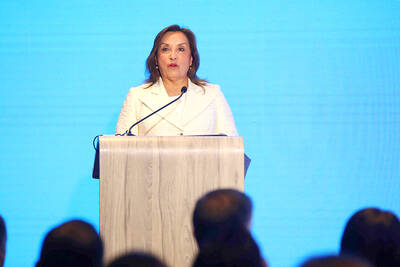North America-based manufacturers of semiconductor equipment posted a book-to-bill ratio of 1.22 last month, Silicon Valley-based Semiconductor Equipment and Materials International (SEMI) reported yesterday, signaling that the semiconductor industry is well on track to a recovery.
A book-to-bill of 1.22 means that US$122 worth of orders was received for every US$100 of product billed for the month.
“The book-to-bill ratio has been above parity for eight months in a row, and three-month average order figures are in the range last reported in late 2007,” Dan Tracy, senior director of SEMI’s Industry Research and Statistics, said in a statement.
“Year-over-year comparisons are dramatic in comparison to the very low figures reported in the first quarter of 2009,” Tracy said.
Last month, US-based semiconductor equipment makers posted US$1.23 billion in orders, growing nearly fourfold from the same period last year, SEMI said.
That also represented a 4.5 percent increase from US$1.18 billion in January, the statement showed.
Separately, SEMI forecast contract chipmakers would spend US$27.2 billion on new equipment this year, up 88 percent from last year rather than the 65 percent estimated previously.
This year, Taiwan is expected to be the biggest buyer of semiconductor equipment again.
SEMI did not provide last year’s figure for comparison.
Taiwan’s two biggest contract chipmakers — Taiwan Semiconductor Manufacturing Co (TSMC, 台積電) and United Microelectronics Corp (聯電) — plan to spend a combined US$6.3 billion on new equipment this year, up from US$3.22 billion last year, the chipmakers have told their investors.
The chipmakers said they were expanding capacity in line with increasing customer demand, especially for chips made on advanced technologies.
Last year, Taiwanese semiconductor companies bought a total of US$4.35 billion in equipment, down 13.2 percent from US$5.01 billion in 2008, SEMI said.
Global semiconductor companies purchased US$15.92 billion in equipment last year, down 46 percent year-on-year, SEMI said.

GROWING CONCERN: Some senior Trump administration officials opposed the UAE expansion over fears that another TSMC project could jeopardize its US investment Taiwan Semiconductor Manufacturing Co (TSMC, 台積電) is evaluating building an advanced production facility in the United Arab Emirates (UAE) and has discussed the possibility with officials in US President Donald Trump’s administration, people familiar with the matter said, in a potentially major bet on the Middle East that would only come to fruition with Washington’s approval. The company has had multiple meetings in the past few months with US Special Envoy to the Middle East Steve Witkoff and officials from MGX, an influential investment vehicle overseen by the UAE president’s brother, the people said. The conversations are a continuation of talks that

With an approval rating of just two percent, Peruvian President Dina Boluarte might be the world’s most unpopular leader, according to pollsters. Protests greeted her rise to power 29 months ago, and have marked her entire term — joined by assorted scandals, investigations, controversies and a surge in gang violence. The 63-year-old is the target of a dozen probes, including for her alleged failure to declare gifts of luxury jewels and watches, a scandal inevitably dubbed “Rolexgate.” She is also under the microscope for a two-week undeclared absence for nose surgery — which she insists was medical, not cosmetic — and is

Nintendo Co hopes to match the runaway success of the Switch when its leveled-up new console hits shelves on Thursday, with strong early sales expected despite the gadget’s high price. Featuring a bigger screen and more processing power, the Switch 2 is an upgrade to its predecessor, which has sold 152 million units since launching in 2017 — making it the third-best-selling video game console of all time. However, despite buzz among fans and robust demand for pre-orders, headwinds for Nintendo include uncertainty over US trade tariffs and whether enough people are willing to shell out. The Switch 2 “is priced relatively high”

Alchip Technologies Ltd (世芯), an application-specific integrated circuit (ASIC) designer specializing in artificial-intelligence (AI) chips, yesterday said that small-volume production of 3-nanometer (nm) chips for a key customer is on track to start by the end of this year, dismissing speculation about delays in producing advanced chips. As Alchip is transitioning from 7-nanometer and 5-nanometer process technology to 3 nanometers, investors and shareholders have been closely monitoring whether the company is navigating through such transition smoothly. “We are proceeding well in [building] this generation [of chips]. It appears to me that no revision will be required. We have achieved success in designing